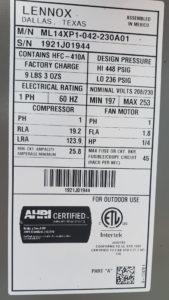It’s springtime, we’re entering air conditioning season, and April is the month that contains Earth Day. It’s the perfect time for a little Refrigerant 101.
Consider this your ultimate guide to air conditioning refrigerant, including what it is, how it works, its environmental impact, and why you should care about any of this.
Some basic facts up front: the refrigerant in your air conditioning system is something that you use every day in warm weather to keep your home comfortable. For this reason alone, a bit of knowledge about refrigerants is helpful, especially if your A/C isn’t working as it should.
Plus, the type of refrigerant in your A/C system impacts your wallet. It affects your system’s energy efficiency, performance, and longevity. This means it affects your energy bills and HVAC maintenance costs.
Today we’re going to discuss the following topics so that you can stay cool, comfortable, and environmentally conscious all at the same time:
- What is A/C Refrigerant?
- Why Should You Care About Your Refrigerant?
- How to Determine What Type of Refrigerant Your Air Conditioner Uses
- How to Identify a Refrigerant Leak
- How to Prevent a Refrigerant Leak
- The Most Environmentally Friendly A/C Refrigerants
- The Most Widely Used A/C Refrigerants
- Refrigerant Changes That Affect You
We think that’s a pretty thorough Refrigerant 101. Let’s get started!
What is A/C Refrigerant?
First up in our Refrigerant 101: what exactly is it?
Well, in the same way that ice cubes keep your drink cold, A/C refrigerant keeps your indoor air cold. It usually takes the form of a gas or liquid. Refrigerant absorbs heat from your indoor air as it circulates through the evaporator coil of a central A/C system. Then the refrigerant carries the heat outside, releasing it into the outdoor air through the condenser coil.
This process — absorbing heat from indoor air and releasing it outside — is how refrigerant works to maintain a comfortable temperature inside your home.
A/C refrigerant is typically packaged in metal cylinders or canisters. These containers hold the refrigerant under pressure and protect it from contamination. The refrigerant itself is usually a colorless gas that is slightly heavier than air and has a faintly sweet odor. It should be handled carefully by an HVAC professional because it can be hazardous to you if you breathe it in or get it on your skin. And it can be hazardous to the environment if it is released.
Why Should You Care About Your Refrigerant?
What is the point of a Refrigerant 101?
Glad you asked! Here are all the reasons to care about the refrigerant your air conditioning system uses.
Refrigerant Levels Matter. A Lot.
Refrigerant is the lifeblood of your air conditioning system. If your refrigerant level is too low, your A/C will work harder to cool your home. This means it will use more energy and saddle you with higher energy bills.
A low refrigerant level can also cause your A/C to freeze up. This leads to costly repairs and potentially a full system replacement much sooner than normal.
On the other hand, if your refrigerant level is too high (which is called “overcharging” your air conditioner), your compressor will need to work harder. This causes premature wear and tear, and even system failure.
The need to maintain a precise refrigerant level is one of the many reasons to choose a quality HVAC company, and not necessarily the cheapest or most instantly available one. We discussed how to choose a quality HVAC pro in our last post.
Refrigerant Impacts Not Only Your Comfort but Your Health.
As we said at the beginning of this post, refrigerant is something you use every day in warm weather to keep your home livable.
And when the temperature goes from warm to bona-fide hot, refrigerant becomes even more critical to your daily well-being. This is even more true if you have vulnerable people in your home, such as seniors, children, or anyone who is medically fragile.
An air conditioning breakdown in hot weather is much more hazardous to everyone’s health than a furnace breakdown in cold weather. If you’re too cold, a sweater fixes that. If you’re too hot, you can end up in the ER.
Your Refrigerant Determines Your Energy Efficiency.
Your HVAC system accounts for most of the energy usage in your home. And the type of refrigerant you use has a huge impact on this energy usage.
Modern refrigerants — meaning the ones that replace R-22, or freon (which we’ll discuss in a bit) — have the following energy-saving features:
- A higher capacity to absorb and release heat than older refrigerants. They move more heat with less energy.
- A higher operating pressure than older refrigerants. They can use equipment that’s smaller and more efficient.
- More stable than older refrigerants. They reduce the risk of energy-hogging and dangerous refrigerant leaks.
How to Determine What Type of Refrigerant Your Air Conditioner Uses
Let’s bring some actionable knowledge into our Refrigerant 101. There are three ways to find out the type of refrigerant your air conditioner uses:
- Consult the owner’s manual that came with your air conditioner.
- Contact a professional HVAC technician.
- Look for a nameplate on your air conditioning unit. This nameplate is typically located on the exterior of the unit, either on the back or on one of the sides. The nameplate contains information such as the unit’s model and serial numbers, efficiency rating, cooling capacity, manufacturer, and refrigerant type. Following is a photo of a nameplate on a Lennox air conditioner that shows the refrigerant type is HFC-410A, better known as R-410A, which we describe a little later in this post.

How to Identify a Refrigerant Leak
Here is more actionable information for our Refrigerant 101: the signs that you may have a refrigerant leak.
If you notice any of the following, you should contact an HVAC pro to check your refrigerant level:
- Reduced cooling efficiency. If your home is not as cool as it used to be or if it takes longer to reach the temperature to which you’ve set your thermostat, you may have a refrigerant leak.
- An increase in your energy bills. An air conditioner with a refrigerant leak has to work harder to maintain the same temperature.
- A hissing or bubbling sound coming from your air conditioning unit. This is a sign of a severe leak, and you should call an HVAC pro right away.
How to Prevent a Refrigerant Leak
To avoid a refrigerant leak in the first place, you should:
- Schedule regular maintenance for your air conditioning system. During routine maintenance, an HVAC technician will address typical wear and tear issues like loose connections, weakening joints, and eroding seals. These are the kinds of things that, if left unchecked, commonly cause refrigerant leaks.
- Avoid overworking your air conditioner. For example, setting your thermostat to a temperature much lower than necessary puts a lot of strain on your system. This leads not only to refrigerant leaks but to A/C system failure.
The Most Environmentally Friendly A/C Refrigerants
Next up in our Refrigerant 101: a discussion of which ones are most environmentally friendly, and why. Here we’re going to get into a bit more detail about refrigerant names and the chemicals in them.
The most environmentally friendly A/C refrigerants available today are A2L refrigerants. A2L is a class that includes several types of refrigerants with different names. If you’re curious about this, a pretty cool outfit called Forward Engineers in Arkansas wrote an article about refrigerant names that you can geek out on.
In this post, we won’t dive into refrigerant naming conventions and history. We save that kind of sparkling conversation for parties.
The important thing to know about A2L refrigerants is that they are:
- High in efficiency
- Low environmental impact
- Low in toxicity
- Non-flammable (which can mean they’re technically still flammable but at a low burning velocity).
The most popular A2L refrigerants are R-32 and R-454B.
Meet R-32
R-32 is environmentally friendly because:
- It has zero ozone depletion capacity. R-32 is a hydrofluorocarbon (HFC), which contains hydrogen atoms. Hydrogen atoms do not harm the earth’s ozone layer. This is in contrast to refrigerants that contain chlorine or bromine atoms (either chlorofluorocarbons, or CFCs; or hydrochlorofluorocarbons, or HCFCs). Chlorine and bromine destroy ozone molecules.
- It requires less refrigerant volume, making it more energy efficient.
- It is safer when exposed to HVAC technicians on the job, or when exposed to consumers in the case of a refrigerant leak.
Meet R-454B
R-454B is environmentally friendly because:
- It has an even lower environmental impact than R-32. This is because R-454B is a hydrofluoric-olefin (HFO). HFOs are not greenhouse gases, whereas HFCs like R-32 are greenhouse gases.
This may seem confusing at first, because we just mentioned above that R-32 is environmentally friendly, with zero ozone depletion capacity and no chlorine or bromine. This is true. It’s just that HFCs are still greenhouse gases. They don’t have an ozone impact, but they do have a climate impact. Meanwhile, HFOs like R-454B have neither an ozone impact nor a climate impact. - It is even more energy efficient than R-32.
- It is closer in operating pressure to legacy refrigerants that many older HVAC systems still use. This means that for many consumers, transitioning to R-454B refrigerant is easier than transitioning to R-32 refrigerant.
The Most Widely Used A/C Refrigerants
Now that you’re up to speed on the most environmentally friendly refrigerants, let’s discuss the most widely-used ones. They’re not always one and the same.
A2L refrigerants (remember, they’re the most environmentally friendly ones), particularly R-32, are the most commonly used refrigerants in Japan, India, and much of Europe.
But A2L refrigerants are not the most widely used in the United States yet.
Instead, the most widely used refrigerant in the United States is R-410A, otherwise known as Puron.
Meet R-410A
R-410A, or Puron, is an HFC, just like R-32 is. In fact, R-410A is a refrigerant blend that contains part R-32.
R-410A is also chlorine-free like R-32 is, making it ozone-friendly.
Here are the main reasons why R-410A is the most used refrigerant in the United States:
- The Environmental Protection Agency (EPA) officially approved R-410A for use in 2010. At that time, the EPA mandated the phase-out of R-22, which is freon. Freon is ozone-depleting, so the EPA chose R-410A as its environmentally friendly replacement.
Thus, in 2010, R-410A became the standard refrigerant used in new A/C systems in the U.S.
Now, in HVAC terms, 2010 wasn’t that long ago. Air conditioning systems can last for many years and even decades. Millions of U.S. homeowners who replaced their A/C systems since 2010 are still happily using these systems and the R-410A they run on. - R-410A has a lower operating pressure than the A2L refrigerants. This means that the equipment in many U.S. A/C systems — air handlers, compressors, refrigerant lines, coils, and other components — would need significant upgrades in order to handle the pressure of A2L refrigerants like R-32.
Another reason that A2L refrigerants haven’t reached full adoption in the U.S. is that millions of homeowners still haven’t had to replace even older air conditioning systems. We’re talking about the ones that still use R-22, or freon.
In fact, you’ll hear many seasoned HVAC pros still referring to R-410A as the “new” refrigerant, and still trying to convince homeowners that it’s time to move away from R-22.
What This Means for You
We’re willing to bet that if you have an air conditioner that was installed any time from 2010 onward, it uses R-410A, or Puron. This is a quality refrigerant with good efficiency, low toxicity, and no ozone impact. It is serving your air conditioner well, and it is containing your environmental impact.
But changes are coming down the pike. Let’s get into them.
Refrigerant Changes That Affect You
We’d be remiss in our Refrigerant 101 if we didn’t inform you about new and recent refrigerant regulations. They impact your air conditioning system, its ongoing maintenance, and your timeline for replacing it.
This means that these regulations impact your household finances.
So here’s what’s happening in the U.S. today when it comes to refrigerant.
The 2020 Freon Ban
In 2020, the EPA banned freon (R-22) from being produced or imported into the United States.
What if you own a freon-powered air conditioner? Well, no one is mandating that you run out and replace it. If it’s still running, you can keep it running. But that will become more and more difficult as the supply of freon becomes more and more scarce.
Plus, the government requires HVAC companies to make a good faith effort not to release freon into the environment as they’re servicing your A/C or repairing a refrigerant leak.
This means that sooner rather than later, most homeowners with air conditioning systems installed before 2010 will need to upgrade to more energy-efficient and environmentally-friendly systems.
The 2023 New Refrigerant Standards
This year, the EPA begins a phase-out of harmful HFC refrigerants. This includes R-410A.
At this point you may be saying, “Hold on a minute. Didn’t you just say that R-410 has no ozone impact?”
Yes, we did say that, and it’s true. As an HFC, R-410A has no ozone impact. But it is a greenhouse gas, which means it has a climate impact.
This phase-out of R-410A is a result of something called the Kigali Amendment to the Montreal Protocol. In late 2022 the U.S. adopted this amendment, which aims to reduce worldwide HFC consumption by over 80% by 2047.
The primary replacements for R-410A are the A2L refrigerants we discussed earlier: R-32 and R454B.
Another question you might be asking now, is, “Didn’t you say that R-32 is also an HFC? Which the U.S. is phasing out?”
Yes, we did say that.
But the reason R-32 is an acceptable replacement for R-410A is because R-32 has a low GWP, which stands for Global Warming Potential. GWP is a metric that compares the warming impacts of different gases to the warming impact of carbon dioxide. The higher the GWP, the more harmful the gas.
There are other A2L refrigerants that are acceptable replacements for R-410A. But they’re used only in mini-split and self-contained air conditioning systems. These refrigerants are:
- R452B
- R454A
- R454C
- R457A
Yet another thing you may be saying if you’ve followed along this far is, “Hold on again. You said earlier that A2L refrigerants operate at a higher pressure, and that most U.S. air conditioners would need to be upgraded to use them.”
Yes, we did say that. That’s true too!
But a few things here:
- There’s no law or mandate that you have to replace or upgrade your A/C system just to use a more environmentally friendly refrigerant. The R-410A phase-out means that when your A/C system does need to be replaced, you must replace it with a system that uses A2L refrigerant.
- HVAC manufacturers are already making A2L-compliant air conditioning systems. When you’re ready to replace your air conditioning system, HVAC manufacturers are ready with products that meet the new standards.
_____________
At Kowalski Heating, Cooling, and Plumbing, we’ll walk you through all the refrigerant questions you have and the regulations that may affect you. When you work with us, we’ll take care of your refrigerant so that you’ll never have to worry about it. And we’ll make sure that you have the most energy-efficient, environmentally friendly air conditioner for your home and your wallet.
Give us a call at 412-952-5923. You can also contact us via our website at any time. We look forward to serving you!





